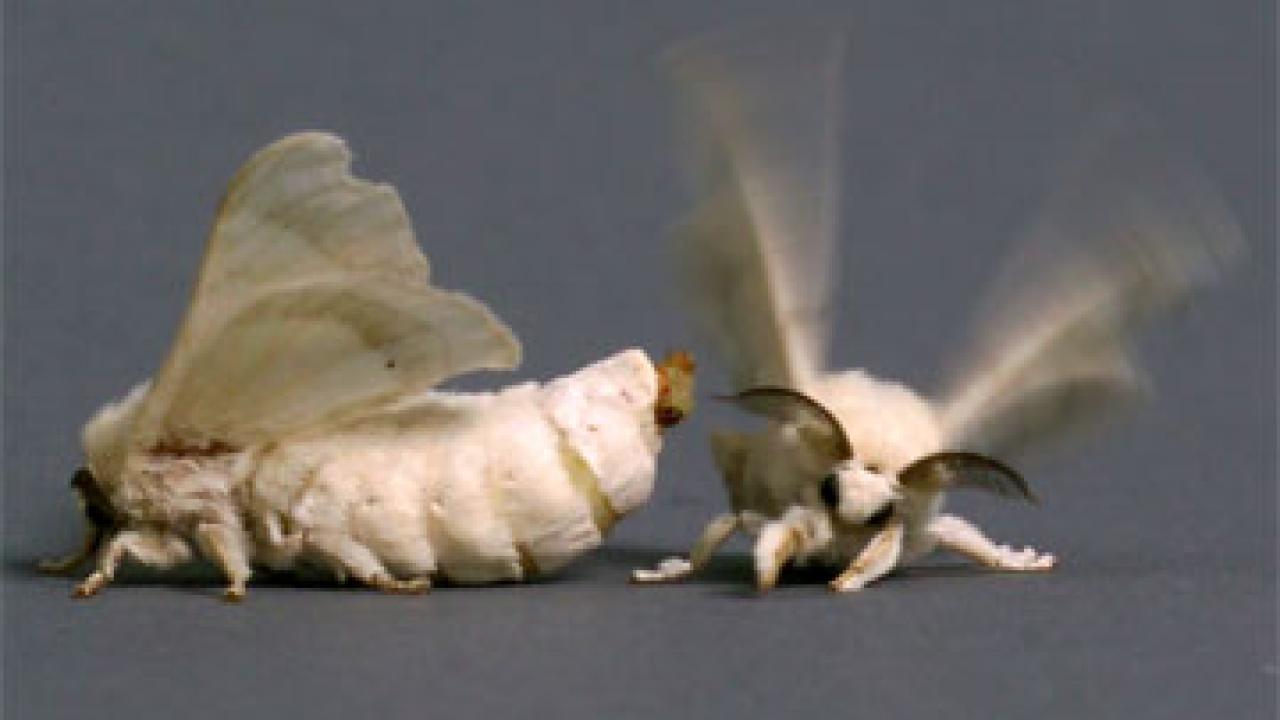It's all about "the birds and the bees." And now, "the silkworm moths and the fruit flies."
A chemical ecologist and a genetics researcher at the University of California, Davis, have joined forces to trick fruit flies into thinking that silkworm moths are potential mates.
Groundbreaking research in the labs of chemical ecologist Walter Leal and genetics researcher Deborah Kimbrell shows that genetically engineered fruit flies responded to the silkworm moth scent of a female.
The practical implications of the findings could be widespread. Methods that can attract or repel insects have important applications for agricultural pests and medical entomology. The research could lead to designing better chemicals to attract insects and designing better chemicals to suppress insect communication. That is because insects communicate, or smell, through their antennae.
Many insect species, including silkworm moths, release sex pheromones or chemical signals to attract a mate. "Silkworm moths utilize smell more strongly than any other senses," said Leal, professor and chair of the Department of Entomology. "Moths keep on the trail of a scent until they find a female."
"We got a very clear response," he said. "Our electrophysiological recordings and direct stimulation testing showed that the transgenic fruit flies definitely responded to the moth pheromone."
The larva, or caterpillar, stage of the silkworm moth, native to China, weaves a cocoon of silk from protein secreted from its two salivary glands. The silk is economically important to the clothing industry.
Meanwhile, the common fruit fly, Drosophila melanogaster, known for hovering around rotting fruit, is considered a model organism or "golden bug," a prized tool for genetic research and developmental studies.
The UC Davis team obtained fruit fly mutants with an empty neuron (or neuron without a receptor) from Yale University molecular biologist John Carlson. The UC researchers then introduced a sex pheromone receptor from the silkworm moth into the fruit fly, tested the signals, and drew a positive response.
Their work, "Pheromone Reception in Fruit Flies Expressing a Moth's Odorant Receptor," is published in the current edition of Proceedings of the National Academy of Sciences.
The project sprang from Leal's mosquito research. He develops and tests "stinky" chemical mixtures that attract female mosquitoes to traps; the mosquitoes are then tested for the presence of the West Nile virus.
As mosquitoes do not utilize species-specific sex pheromones and are not as amenable to genetic manipulations as fruit flies, Leal used the fruit fly-silkworm system to address important olfactory questions.
"In native moth populations, such as the peacock moths, sex pheromones are so sensitive that males can detect female moths from several miles away," Leal said. "With the discovery of the first sex pheromone from the silkworm moth (Bombyx mori), it became evident that insects rely on compounds called semiochemicals to recognize not only potential mates, but also prey and specific features of the environment." Semiochemicals are compounds used in communication; pheromones are a subclass of semiochemicals.
Using the 17,000 sensilla, or receptors, on its antennae, the silkworm moth detects not only the major constituent of the sex pheromone, bombykol, but also a second compound, bombykal that is released by the female pheromone gland.
Leal explained that the pheromone-detecting sensilla house two olfactory receptor neurons, one specifically tuned to bombykol and the other to bombykal.
The molecular basis underlying the "extraordinary selectivity and sensitivity" of the insect's "nose" is still unknown, he said. Unlike fruit flies, silkworm moths are not readily amenable to genetic manipulation.
Kimbrell said Drosophila is an excellent model for genetic manipulation, but the fruit fly does not smell pheromones as strongly as the silkworm moth. "We used the powerful Gal4-UAS system of Drosophila to produce transgenic flies," she said. "This system allows for the expression of virtually any gene, from any organism, into specific cells and tissues of Drosophila."
Leal specializes in the identification and synthesis of insect sex pheromones and the chemical ecology and chemical communication of insects and potential applications for pest control.
Kimbrell, an associate research geneticist in the Section of Molecular and Cellular Biology, College of Biological Sciences, is an expert on fruit flies. A NASA investigator studying fruit flies in space, she is researching the immune systems of the fruit flies launched into space last July aboard the space shuttle Discovery. The human and fruit fly immune systems are similar, she said.
The research team headed by Leal and Kimbrell includes post-doctorate researchers Zainulabeuddin Syed and Yuko Ishida in the Leal lab, and Kimbrell lab junior scientist Katherine Taylor, now a medical student at UC Irvine.
Grants from the National Institutes of Health, National Science Foundation, U.S. Department of Agriculture and the National Aeronautics and Space Administration funded the research.
The paper is online at http://www.pnas.org/cgi/doi/10.1073/pnas.0607874103.
Media Resources
Andy Fell, Research news (emphasis: biological and physical sciences, and engineering), 530-752-4533, ahfell@ucdavis.edu
Walter Leal, Entomology, 530-752-7755, wsleal@ucdavis.edu
Deborah Kimbrell, Molecular and Cellular Biology, (530) 752-1116, dakimbrell@ucdavis.edu
Kathy Keatley Garvey, Entomology, 530-754-6894, kegarvey@ucdavis.edu
